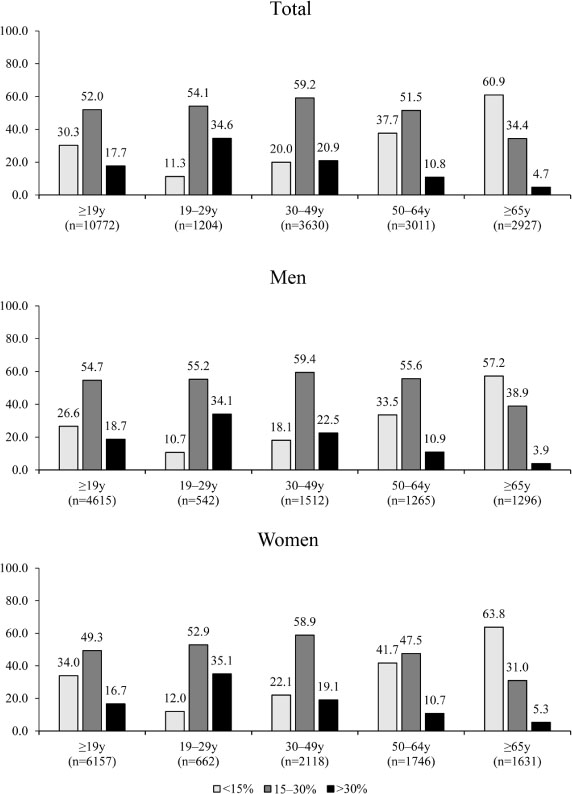References
1. World Health Organization (WHO). Diet, nutrition and the prevention of chronic diseases: Report of a joint WHO/FAO expert consultation WHO; 2003. WHO Technical Report Series no. 916.
2. Korea Centers for Disease Control and Prevention (KCDC). Ministry of Health and Welfare (MoHW). Current status and issues regarding chronic disease KCDC; 2018. 12.
3. Statistics Korea. Cause-of-death statistics in 2017 in the Republic of Korea [internet] National Center for Health Statistics; 2018. cited 2018 Sep 19. Available from:
http://kostat.go.kr.
4. Pot GK, Prynne CJ, Roberts C, Olson A, Nicholson SK, Whitton C, et al. National Diet and Nutrition Survey: fat and fatty acid intake from the first year of the rolling programme and comparison with previous surveys. Br J Nutr 2012;107(3):405–415.
5. Li K, McNulty BA, Tiernery AM, Devlin NF, Joyce T, Leite JC, et al. Dietary fat intakes in Irish adults in 2011: how much has changed in 10 years? Br J Nutr 2016;115(10):1798–1809.
6. Sette S, Le Donne C, Piccinelli R, Arcella D, Turrini A, Leclercq C, et al. The third Italian national food consumption survey, INRAN-SCAI 2005-06-part 1: nutrient intakes in Italy. Nutr Metab Cardiovasc Dis 2011;21(12):922–932.
7. National Center for Health Statistics (NCHS). Health, United States, 2016: With chartbook on long-term trends in health Washington, DC: NCHS; 2017.
8. Song S, Shim JE, Song WO. Trends in total fat and fatty acid intakes and chronic health conditions in Korean adults over 2007–2015. Public Health Nutr 2019;22(8):1341–1350.
9. Hooper L, Martin N, Abdelhamid A, Smith GD. Reduction in saturated fat intake for cardiovascular disease. Cochrane Database Syst Rev 2015;(6)CD011737.
10. Hu FB, Stampfer MJ, Manson JE, Rimm E, Colditz GA, Rosner BA, et al. Dietary fat intake and the risk of coronary heart disease in women. N Engl J Med 1997;337(21):1491–1499.
11. Jakobsen MU, O'Reilly EJ, Heitmann BL, Pereira MA, Bälter K, Fraser GE, et al. Major types of dietary fat and risk of coronary heart disease: a pooled analysis of 11 cohort studies. Am J Clin Nutr 2009;89(5):1425–1432.
12. Mozaffarian D, Micha R, Wallace S. Effects on coronary heart disease of increasing polyunsaturated fat in place of saturated fat: a systematic review and meta-analysis of randomized controlled trials. PLoS Med 2010;7(3)e1000252.
13. Wong ND. Epidemiological studies of CHD and the evolution of preventive cardiology. Nat Rev Cardiol 2014;11(5):276–289.
14. Mensink RP. Effects of saturated fatty acids on serum lipids and lipoproteins: A systematic review and regression analysis Geneva: WHO; 2016.
15. Kweon S, Kim Y, Jang MJ, Kim Y, Kim K, Choi S, et al. Data resource profile: the Korea National Health and Nutrition Examination Survey (KNHANES). Int J Epidemiol 2014;43(1):69–77.
16. The Korean Nutrition Society. Dietary reference intakes for Koreans 2015 Seoul: MoHW & the Korean Nutrition Society; 2016.
17. Anderson JW, Randles KM, Kendall CW, Jenkins DJ. Carbohydrate and fiber recommendations for individuals with diabetes: a quantitative assessment and meta-analysis of the evidence. J Am Coll Nutr 2004;23(1):5–17.
18. Li Y, Hruby A, Bernstein AM, Ley SH, Wang DD, Chiuve SE, et al. Saturated fats compared with unsaturated fats and sources of carbohydrates in relation to risk of coronary heart disease: a prospective cohort study. J Am Coll Cardiol 2015;66(14):1538–1548.
19. Welsh JA, Sharma A, Abramson JL, Vaccarino V, Gillespie C, Vos MB. Caloric sweetener consumption and dyslipidemia among US adults. JAMA 2010;303(15):1490–1497.
20. Korea Center for Disease Control and Prevention. Ministry of Health and Welfare. Korea Health Statistics 2017: Korea National Health and Nutrition Examination Survey (KNHANES VII-1) MoHW; 2018. 12.
21. Robinson SF, Quarfordt SH. The effect of ethanol on lipoprotein metabolism. Alcohol Clin Exp Res 1981;5(1):101–109.
22. Siler SQ, Neese RA, Hellerstein MK. De novo lipogenesis, lipid kinetics, and whole-body lipid balances in humans after acute alcohol consumption. Am J Clin Nutr 1999;70(5):928–936.
23. Rimm EB, Williams P, Fosher K, Criqui M, Stampfer MJ. Moderate alcohol intake and lower risk of coronary heart disease: meta-analysis of effects on lipids and haemostatic factors. BMJ 1999;319(7224):1523–1528.
24. Pownall HJ, Ballantyne CM, Kimball KT, Simpson SL, Yeshurun D, Gotto AM Jr. Effect of moderate alcohol consumption on hypertriglyceridemia: a study in the fasting state. Arch Intern Med 1999;159(9):981–987.




